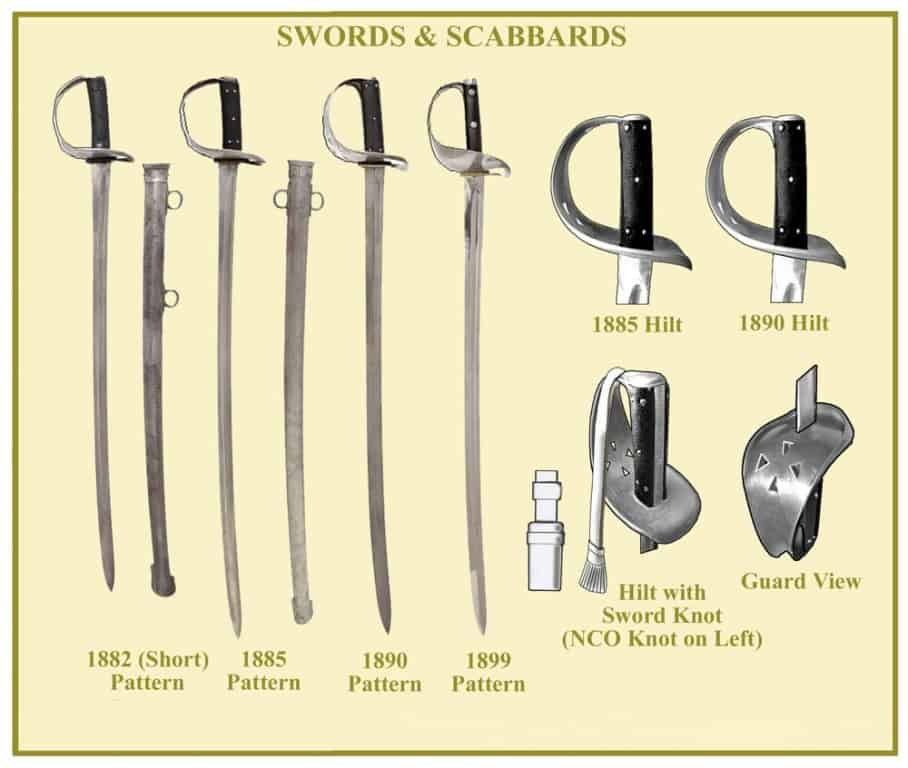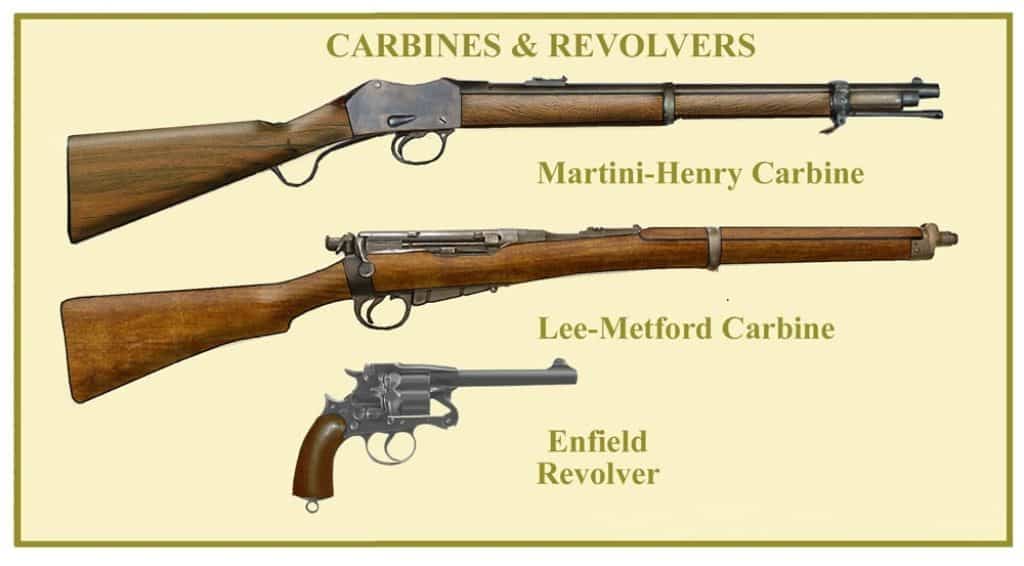SWORDS
The first universal sword for the entire cavalry arm was the 1853 pattern which was modified in 1864 to a bowl guard, with pierced Maltese cross, replacing the cast-iron three bar guard (which broke regularly).
This was the sword carried in all the conflicts from the Abyssinian campaign to the Egyptian campaign. The 1864 pattern sword was essentially a thrusting weapon and experiences against heavily robed native adversaries in the Third Afghan War and the Egyptian Campaign highlighted these shortcomings. In short, the sword blades were blunt and ineffective as slashing weapons.
The 1882 pattern, which came in two lengths (the shorter for light cavalry), proved to be even worse and its failures, along with the infantry bayonet, led to another scandal.
On this pattern the sheet steel bowl guard was lapped at the edges thereby preventing the tearing of tunic skirts which was a problem. The howl of outrage to this sword, especially during the Sudan campaign led to another reappraisal and a new testing system which produced the 1885 pattern sword.
Apart from an improved and heavier blade it was no better than the 1882 version. Some modifications were made such as a pad at the top of the guard to protect the scabbard mouth.
To accommodate the carrying of the sword on the saddle, the rings for the sword slings were fixed to either side of the scabbard mouth.
It should be noted that most of the sword and bayonet blades used in the British Army at this time were manufactured in Solingen, Germany. However, the problem always seemed to be design rather than material.
More committees and more trials followed before the 1890 pattern sword was authorized. The blade was again made heavier and more fullered and the hilt was further modified with a metal inset between the top of the guard and the grip.
This sword was still not much of an improvement, but was carried for over ten years.
The 1899 pattern sword, which by the time it had largely been issued was outside the scope of this account, was little different than the 1890 pattern except that the guard was again modified, this time doing away with the Maltese cross piercing and increasing the bowl size over the knuckles.
Ironically, eight years into the next century, the British produced what has been described as “the perfect cavalryman’s sword”. This pattern sword was the last in the British army as its introduction coincided with the demise of cavalry and saw little use during the Great War and it is purely a ceremonial item today.
The swords, with specifications, in use during this period are as follows:
1882 Pattern (long) – Blade Length 35⅜ ins – Weight 2lb 3 oz
1882 Pattern (Short) – Blade Length 33 ins – Weight 2 lb 2.5 oz
1885 Pattern – Blade Length 34 ½ ins – Weight 2 lb 2 oz
1890 Pattern – Blade Length 34 ½ Ins – Weight 2 lb 4 oz
1899 Pattern – Blade Length 34 ½ Ins – Weight 2 lb 9 oz
SWORD KNOTS
Hussars, like all British cavalry had a simple sword knot. It was a flat leather strap that was looped through a slit in the bottom of the sword hilt then formed into a fringed tassel at the end.
The approximately 15in loop would go around the wrist when in action to prevent the sword falling from the hand. It had changed little since the 18th century.
NCOs of cavalry had a plain un-fringed tassel. Before the 1882 pattern sword, the slit was at the top of the guard.

CARBINES & REVOLVERS
Whatever the shortcomings of the British “Arme Blanche”, there was no such problem with the firearms carried by the British cavalry at this time.
The Martini-Henry single shot, breech-loading rifle with the lever action, which replaced the Snider breech-loader, was generally issued to the infantry from about 1874 and the carbine version went into production in about 1877 after extensive trials and efforts to reduce the notoriously heavy recoil.
A reduced charge somewhat reduced the recoil issue and it was taken into use during the 3rd Afghan War and favourably received by the cavalry regiments who went into action with it.
Thereafter the Martini-Henry carbine remained standard until well into the 1890s. It used a 0.450 Boxer cartridge, was 37 ½ ins long and weighed 7 ½ lbs.
It was carried by hussars on guard duty, both mounted and dismounted. The Snider carbine was the last carried on a swivel as the Martini was placed in a ‘bucket’ on the off-side of the saddle.
The .45 black powder cartridge was heavy, provided a strong recoil and contributed to the overheating of the Martini barrel. Also, the advent of the magazine now put the single shot feature at a disadvantage.
The Lee-Metford bolt-action magazine rifle issued to the infantry from 1888 was issued to cavalry in a carbine version from 1894. This weapon used a .303 cartridge, had a 5 round box magazine, was 40 ins long and weighed 7.7 lbs.
The timing of the Lee-Metford was somewhat unfortunate as it still used black powder and smokeless powder was developed soon after.
Two years later, the Lee-Metford was converted to smokeless powder and the barrel was replaced by the Enfield version.
This produced the first Lee-Enfield rifle followed in 1898 by the carbine version.
Most cavalry regiments were using the six-round magazine Lee-Enfield Carbine during the Boer War which was the last cavalry carbine used by the British Army, being replaced by the universal Short Magazine Lee Enfield (SMLE) in 1902-04.
Those NCOs and soldiers permitted to use a side firearm carried the Enfield revolver for most of the period.
The carrying of revolvers was also extended to trumpeters and orderlies. The Webley Mark III was issued to certain NCOs after 1895.

LANCES
Unlike hussars in Germany and Russia, British hussars did not ever carry the lance either on parade or on campaign in keeping with their true role as light cavalry.


